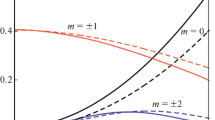Abstract:
The diffraction of laser-cooled atoms from a spatially-periodic potential is modelled using rigorous coupled-wave analysis. This numerical technique, normally applied to light-diffraction, is adapted for use with atomic de Broglie waves incident on a reflecting diffraction grating. The technique approximates the potential by a large number of constant layers and successively solves the complex eigenvalue problem in each layer, propagating the solution up to the surface of the grating. The method enables the diffraction efficiencies to be calculated for any periodic potential. The results from the numerical model are compared with the thin phase-grating approximation formulae for evanescent light-wave diffraction gratings and idealised magnetic diffraction gratings. The model is applied to the problem of diffracting Rb atoms from a grating made from an array of permanent magnets.
Similar content being viewed by others
Author information
Authors and Affiliations
Additional information
Received 13 June 2000 and Received in final form 15 December 2000
Rights and permissions
About this article
Cite this article
Davis, T. Modelling the diffraction of laser-cooled atoms from magnetic gratings. Eur. Phys. J. D 14, 111–118 (2001). https://doi.org/10.1007/s100530170242
Issue Date:
DOI: https://doi.org/10.1007/s100530170242



